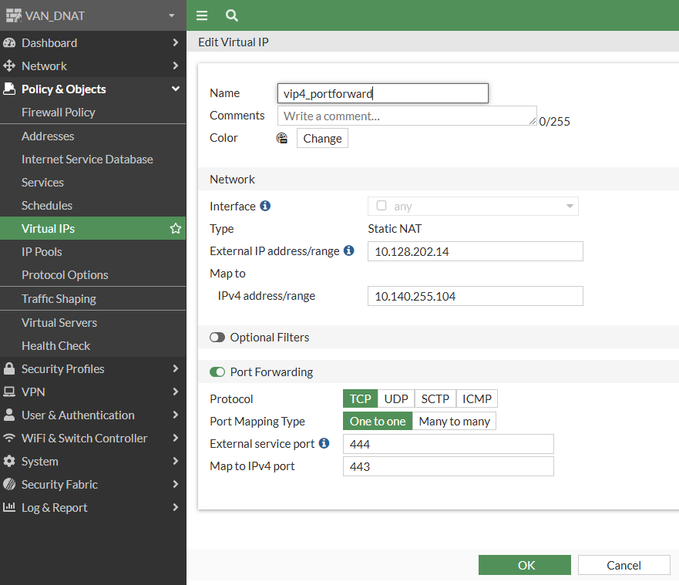- Support Forum
- Knowledge Base
- Customer Service
- Internal Article Nominations
- FortiGate
- FortiClient
- FortiADC
- FortiAIOps
- FortiAnalyzer
- FortiAP
- FortiAuthenticator
- FortiBridge
- FortiCache
- FortiCare Services
- FortiCarrier
- FortiCASB
- FortiConverter
- FortiCNP
- FortiDAST
- FortiData
- FortiDDoS
- FortiDB
- FortiDNS
- FortiDLP
- FortiDeceptor
- FortiDevice
- FortiDevSec
- FortiDirector
- FortiEdgeCloud
- FortiEDR
- FortiEndpoint
- FortiExtender
- FortiGate Cloud
- FortiGuard
- FortiGuest
- FortiHypervisor
- FortiInsight
- FortiIsolator
- FortiMail
- FortiManager
- FortiMonitor
- FortiNAC
- FortiNAC-F
- FortiNDR (on-premise)
- FortiNDRCloud
- FortiPAM
- FortiPhish
- FortiPortal
- FortiPresence
- FortiProxy
- FortiRecon
- FortiRecorder
- FortiSRA
- FortiSandbox
- FortiSASE
- FortiSASE Sovereign
- FortiScan
- FortiSIEM
- FortiSOAR
- FortiSwitch
- FortiTester
- FortiToken
- FortiVoice
- FortiWAN
- FortiWeb
- FortiAppSec Cloud
- Lacework
- Wireless Controller
- RMA Information and Announcements
- FortiCloud Products
- ZTNA
- 4D Documents
- Customer Service
- Community Groups
- Agora
- Engage Services
- The EPSP Platform
- The ETSP Platform
- Finland
- FortiCare Service Development
- FortiGate-VM on Azure
- FortiGate-VM on AWS
- FortiGate CNF (All Marketplaces)
- FortiWeb Cloud (All Marketplaces)
- Fortinet for SAP
- FortiSIEM
- FortiSOAR
- KCS
- Lacework
- Super User
- Agora
- Engage Services
- The EPSP Platform
- The ETSP Platform
- Finland
- FortiCare Service Development
- FortiGate-VM on Azure
- FortiGate-VM on AWS
- FortiGate CNF (All Marketplaces)
- FortiWeb Cloud (All Marketplaces)
- Fortinet for SAP
- FortiSIEM
- FortiSOAR
- KCS
- Lacework
- Super User
- Agora
- Blogs
- Fortinet Community
- Knowledge Base
- FortiGate
- Technical Tip: FortiOS Destination NAT (DNAT) logi...
- Subscribe to RSS Feed
- Mark as New
- Mark as Read
- Bookmark
- Subscribe
- Printer Friendly Page
- Report Inappropriate Content
| Description | This article describes the default FortiOS Destination NAT behavior when Central NAT is not in use. |
| Scope | FortiOS. |
| Solution |
This article assumes central NAT is disabled. For configuring Destination NAT when central NAT is enabled, see 'Central DNAT' in the Administration Guide.
Destination NAT policies are visible in the CLI using “diagnose firewall iprope list 100000”. See the v7.0 New Features guide 'Record Central NAT and DNAT hit count'. diagnose firewall iprope list 100000 policy index=2 uuid_idx=669 action=accept [policy index depends on configuration order. uuid_idx of a VIP does not change] [6:0x0:0/(0,65535)->(444,444)] flags:0 helper:auto [TCP port forwarding for 444->443 is applied] nat(1): flag=0 base=10.128.202.17:444 10.140.255.102-10.140.255.102(443:443) [Internal IP:port of VIP]
policy index=4294967295 uuid_idx=0 action=drop [Implicit deny NAT policy]
vip3 will not be matched, since vip2 is above it in the Virtual IP list and both are configured in a firewall policy. In FortiOS v7.2 and later, it is possible to re-order NAT objects using the cli. See the article 'Virtual IP (VIP) port forwarding order of execution' for how to move Virtual IP objects.
Traffic will only match the virtual IP if the external IP and external service port match.
Where optional source address or services filters are configured, the traffic will only match the virtual IP if it also matches the filters. If both source address and services filters are configured, traffic must match both.
config firewall vip edit "vip6-restricted to wan2 and dmz" set extip 10.128.202.14 next end
Common misconfigurations:
To allow the Virtual IP to only match on specific interfaces, use a 'srcintf-filter' as described earlier in this article. Result:
By understanding FortiGate Destination NAT behavior and the available filtering options, an administrator can better configure Virtual IPs to match intended traffic and effectively troubleshoot when intended destination NAT is not chosen. For further Destination NAT troubleshooting steps, see the article '(Troubleshooting VIP (port forwarding)'. |
The Fortinet Security Fabric brings together the concepts of convergence and consolidation to provide comprehensive cybersecurity protection for all users, devices, and applications and across all network edges.
Copyright 2025 Fortinet, Inc. All Rights Reserved.




